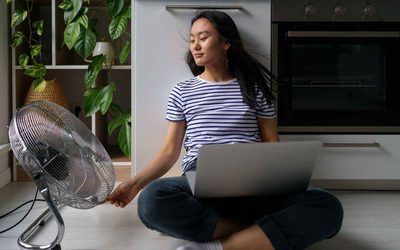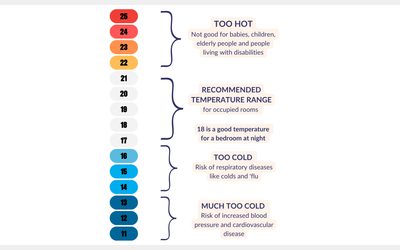- Help & Advice /
- Avoiding overheating at home
Avoiding overheating at home
We talk a lot about cold homes in winter but what can you do if your home gets too hot?

Overheating - the risks
Overheating can have serious consequences for health. The illustration below highlights the risks of overheating and the recommended temperature range:

As British summers grow hotter and homes can struggle to stay cool, many householders are looking for solutions to the problem of overheating.
Whilst it may be tempting to opt for air conditioning units, these have both financial and environmental impacts. Running a portable air conditioning unit for just a few hours a day can add over £100 to your summer electricity bill.
But overheating isn’t inevitable. With a mix of retrofit measures, smart design and changes to everyday habits, homes can be adapted to stay cooler even in warmer weather.
Why some homes overheat more than others
Certain types of homes are particularly vulnerable to overheating:
- Modern flats and new builds
- South and East facing homes
- Homes with lots of glazing
- Top floor flats with less shade.
No matter your house type, if you are looking for lower cost, lower carbon ways to stay cool, there are simple changes that can make a big difference:
Start with behaviour:
- Open windows/doors only when its colder outside than it is inside, usually first thing in the morning and late at night, close them when the temperature rises. Where possible open windows on opposite sides of the house (e.g. an upstairs front window and a downstairs rear window) to cross ventilate.
- Keep curtains/blinds closed during the day to block out direct sunlight.
- Use fans, these are much cheaper to purchase and run than air conditioning units. Fans are only effective at cooling when blowing air directly onto you - if they are just circulating warm air around the room they will have little effect. Try placing a bowl of ice or a damp cloth in front of a fan to boost the cooling effect.
- Switch off unnecessary lights/appliances as they all give off heat.
Low-cost DIY home tweaks:
- Installing loft insulation keeps your home cool by reducing the amount of heat entering through the roof.
- Fit reflective window film or insulated black out curtains.
- Fit reflective or thermal blinds.
- Seal gaps around windows and doors to stop the warm air getting in.
- Consider adding trickle vents to windows to allow better airflow.
More advanced options:
- Fit external shading such as shutters or awnings
- Cavity wall insulation helps to keep internal temperatures stable.
- External wall insulation with light coloured render that reflects sunlight and adds thermal protection.
- Add mechanical extract ventilation.
Cool your surroundings too:
- Create shade outside the home by planting trees and shrubs for natural shade, particularly to the South and West of your home where they will block the strongest of the afternoon sun.
- Use light coloured materials for patios, paving and walls-these reflect rather than absorb heat.
- Avoid artificial grass and dark surfaces, which can reach dangerously high temperatures in direct sun.
- Consider installing a water feature. Water has a natural cooling effect through evaporation, even a small pond can lower surrounding air temperatures (consider the safety of children and pets).
Keeping your home cool is possible - with a little know-how, a few simple changes and smart timing you can beat the heat and protect your health.